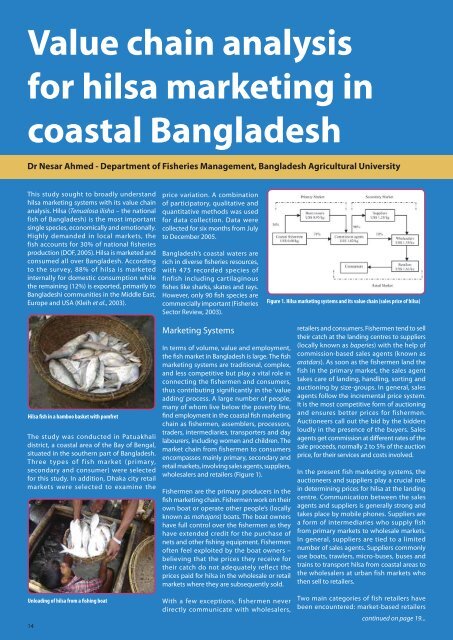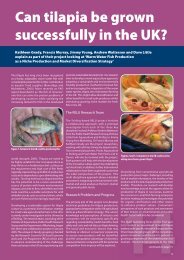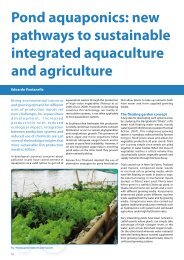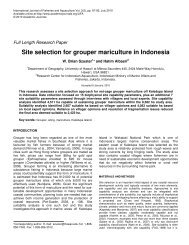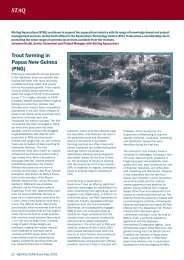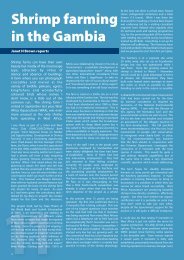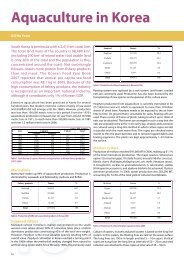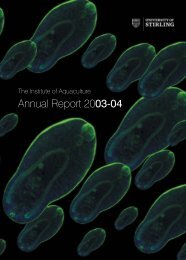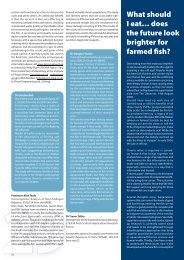Value chain analysis for hilsa, Bangladesh - Institute of Aquaculture
Value chain analysis for hilsa, Bangladesh - Institute of Aquaculture
Value chain analysis for hilsa, Bangladesh - Institute of Aquaculture
You also want an ePaper? Increase the reach of your titles
YUMPU automatically turns print PDFs into web optimized ePapers that Google loves.
<strong>Value</strong> <strong>chain</strong> <strong>analysis</strong><br />
<strong>for</strong> <strong>hilsa</strong> marketing in<br />
coastal <strong>Bangladesh</strong><br />
Dr Nesar Ahmed - Department <strong>of</strong> Fisheries Management, <strong>Bangladesh</strong> Agricultural University<br />
This study sought to broadly understand<br />
<strong>hilsa</strong> marketing systems with its value <strong>chain</strong><br />
<strong>analysis</strong>. Hilsa (Tenualosa ilisha – the national<br />
fish <strong>of</strong> <strong>Bangladesh</strong>) is the most important<br />
single species, economically and emotionally.<br />
Highly demanded in local markets, the<br />
fish accounts <strong>for</strong> 30% <strong>of</strong> national fisheries<br />
production (DOF, 2005). Hilsa is marketed and<br />
consumed all over <strong>Bangladesh</strong>. According<br />
to the survey, 88% <strong>of</strong> <strong>hilsa</strong> is marketed<br />
internally <strong>for</strong> domestic consumption while<br />
the remaining (12%) is exported, primarily to<br />
<strong>Bangladesh</strong>i communities in the Middle East,<br />
Europe and USA (Kleih et al., 2003).<br />
price variation. A combination<br />
<strong>of</strong> participatory, qualitative and<br />
quantitative methods was used<br />
<strong>for</strong> data collection. Data were<br />
collected <strong>for</strong> six months from July<br />
to December 2005.<br />
<strong>Bangladesh</strong>’s coastal waters are<br />
rich in diverse fisheries resources,<br />
with 475 recorded species <strong>of</strong><br />
finfish including cartilaginous<br />
fishes like sharks, skates and rays.<br />
However, only 90 fish species are<br />
commercially important (Fisheries<br />
Sector Review, 2003).<br />
Figure 1. Hilsa marketing systems and its value <strong>chain</strong> (sales price <strong>of</strong> <strong>hilsa</strong>)<br />
Hilsa fish in a bamboo basket with pomfret<br />
The study was conducted in Patuakhali<br />
district, a coastal area <strong>of</strong> the Bay <strong>of</strong> Bengal,<br />
situated in the southern part <strong>of</strong> <strong>Bangladesh</strong>.<br />
Three types <strong>of</strong> fish market (primary,<br />
secondary and consumer) were selected<br />
<strong>for</strong> this study. In addition, Dhaka city retail<br />
markets were selected to examine the<br />
1414<br />
Unloading <strong>of</strong> <strong>hilsa</strong> from a fishing boat<br />
Marketing Systems<br />
In terms <strong>of</strong> volume, value and employment,<br />
the fish market in <strong>Bangladesh</strong> is large. The fish<br />
marketing systems are traditional, complex,<br />
and less competitive but play a vital role in<br />
connecting the fishermen and consumers,<br />
thus contributing significantly in the ‘value<br />
adding’ process. A large number <strong>of</strong> people,<br />
many <strong>of</strong> whom live below the poverty line,<br />
find employment in the coastal fish marketing<br />
<strong>chain</strong> as fishermen, assemblers, processors,<br />
traders, intermediaries, transporters and day<br />
labourers, including women and children. The<br />
market <strong>chain</strong> from fishermen to consumers<br />
encompasses mainly primary, secondary and<br />
retail markets, involving sales agents, suppliers,<br />
wholesalers and retailers (Figure 1).<br />
Fishermen are the primary producers in the<br />
fish marketing <strong>chain</strong>. Fishermen work on their<br />
own boat or operate other people’s (locally<br />
known as mahajans) boats. The boat owners<br />
have full control over the fishermen as they<br />
have extended credit <strong>for</strong> the purchase <strong>of</strong><br />
nets and other fishing equipment. Fishermen<br />
<strong>of</strong>ten feel exploited by the boat owners –<br />
believing that the prices they receive <strong>for</strong><br />
their catch do not adequately reflect the<br />
prices paid <strong>for</strong> <strong>hilsa</strong> in the wholesale or retail<br />
markets where they are subsequently sold.<br />
With a few exceptions, fishermen never<br />
directly communicate with wholesalers,<br />
retailers and consumers. Fishermen tend to sell<br />
their catch at the landing centres to suppliers<br />
(locally known as baperies) with the help <strong>of</strong><br />
commission-based sales agents (known as<br />
aratdars). As soon as the fishermen land the<br />
fish in the primary market, the sales agent<br />
takes care <strong>of</strong> landing, handling, sorting and<br />
auctioning by size-groups. In general, sales<br />
agents follow the incremental price system.<br />
It is the most competitive <strong>for</strong>m <strong>of</strong> auctioning<br />
and ensures better prices <strong>for</strong> fishermen.<br />
Auctioneers call out the bid by the bidders<br />
loudly in the presence <strong>of</strong> the buyers. Sales<br />
agents get commission at different rates <strong>of</strong> the<br />
sale proceeds, normally 2 to 5% <strong>of</strong> the auction<br />
price, <strong>for</strong> their services and costs involved.<br />
In the present fish marketing systems, the<br />
auctioneers and suppliers play a crucial role<br />
in determining prices <strong>for</strong> <strong>hilsa</strong> at the landing<br />
centre. Communication between the sales<br />
agents and suppliers is generally strong and<br />
takes place by mobile phones. Suppliers are<br />
a <strong>for</strong>m <strong>of</strong> intermediaries who supply fish<br />
from primary markets to wholesale markets.<br />
In general, suppliers are tied to a limited<br />
number <strong>of</strong> sales agents. Suppliers commonly<br />
use boats, trawlers, micro-buses, buses and<br />
trains to transport <strong>hilsa</strong> from coastal areas to<br />
the wholesalers at urban fish markets who<br />
then sell to retailers.<br />
Two main categories <strong>of</strong> fish retailers have<br />
been encountered: market-based retailers<br />
continued on page 19...
Sorting and grading <strong>of</strong> <strong>hilsa</strong> at primary market<br />
and itinerant retailers (fish vendors, hawkers,<br />
etc). Retail sales are made at stalls in fish<br />
markets and door-to-door to household<br />
customers. Fish are traded whole, un-gutted,<br />
and fresh without processing apart from<br />
sorting and icing. More than 75% <strong>of</strong> the total<br />
<strong>hilsa</strong> catch is actually consumed away from<br />
the coast so it requires processing, icing<br />
and transportation. A large number <strong>of</strong> day<br />
labourers, including women and children, are<br />
involved in the process. The travel duration<br />
between primary markets and retail <strong>for</strong> urban<br />
markets is usually less than 12 hours. If the<br />
transportation time is less than six hours<br />
from primary market to retail point the fish<br />
is not iced, or if iced, it is not done properly.<br />
There is a large gap between supply and<br />
demand, thus <strong>hilsa</strong> marketing is very easy<br />
in primary, secondary and retail markets.<br />
Table 1. Calculation <strong>of</strong> marketing margin and pr<strong>of</strong>it <strong>for</strong> <strong>hilsa</strong> in different markets<br />
Markets Particulars <strong>of</strong> marketing US$/kg Share*<br />
(%) <strong>of</strong><br />
Purchase Price (PP) 0.88<br />
Primary Market<br />
Marketing Costs (MC) 0.05<br />
Sales Price (SP) 1.02<br />
55%<br />
Marketing Margin (MM=SP-PP) 0.14<br />
Marketing Pr<strong>of</strong>it (MP=MM-MC) 0.09<br />
Purchase Price (PP) 1.02<br />
Secondary Market<br />
Marketing Costs (MC) 0.07<br />
Sales Price (SP) 1.39<br />
63%<br />
Marketing Margin (MM=SP-PP) 0.37<br />
Marketing Pr<strong>of</strong>it (MP=MM-MC) 0.30<br />
Purchase Price (PP) 1.39<br />
Retail Market<br />
Marketing Costs (MC) 0.04<br />
Sales Price (SP) 1.61<br />
86%<br />
Marketing Margin (MM=SP-PP) 0.22<br />
Marketing Pr<strong>of</strong>it (MP=MM-MC) 0.18<br />
Consumers Price 1.61 100%<br />
* Share <strong>of</strong> consumer price = (Purchase price/ Consumer price) x 100 Source: Survey data (2005)<br />
within the domestic economy while at the<br />
same time understanding the manner in<br />
which marketing people are participating in<br />
the national economy (Kanji and Barrientos,<br />
2002). Analysing value <strong>chain</strong>s can bridge<br />
the gap between the focus <strong>of</strong> mainstream<br />
economics on aggregate measures <strong>of</strong> poverty<br />
such as income and the stress <strong>of</strong> livelihoods<br />
perspectives on micro-level complexity. In fish<br />
marketing systems, value <strong>chain</strong> is a structure<br />
Marketing<br />
margin (%)<br />
63 -55 = 8%<br />
86 - 63 = 23%<br />
100 - 86 =<br />
14%<br />
For <strong>hilsa</strong> value <strong>chain</strong> <strong>analysis</strong>, variables like<br />
marketing costs, marketing margins, number<br />
<strong>of</strong> middlemen in the marketing channel,<br />
distance between primary and retail markets,<br />
and consumers’ behaviour on price are<br />
Auctioning <strong>of</strong> <strong>hilsa</strong> at landing site<br />
Figure 2. The concept <strong>of</strong> a value <strong>chain</strong> (Trondsen et al., 2004)<br />
The demand <strong>for</strong> <strong>hilsa</strong> is high in markets but<br />
supply is limited, and a strong network has<br />
developed with intermediaries and traders<br />
intervening between fishermen at one end<br />
and the consumers at the other.<br />
<strong>Value</strong> Chain Analysis<br />
The value <strong>chain</strong> describes the full range <strong>of</strong><br />
activities which are required to bring a product<br />
or service from conception, through the<br />
different phases <strong>of</strong> production and delivery<br />
to final consumers (Porter, 1980; Kaplinsky<br />
and Morris, 2000). In reality, value <strong>chain</strong>s<br />
tend to be extended with a whole range <strong>of</strong><br />
activities within each link and links between<br />
different value <strong>chain</strong>s (Jacinto, 2004). <strong>Value</strong><br />
<strong>chain</strong> <strong>analysis</strong> can be a useful analytical tool<br />
in understanding the policy environment in<br />
terms <strong>of</strong> efficiency in allocation <strong>of</strong> resources<br />
<strong>of</strong> physical, economic and social transactions<br />
between individuals and organisations<br />
engaged in raw material trans<strong>for</strong>mation<br />
into end products (Figure 2). Flows <strong>of</strong> fish<br />
products and money are exchanged through<br />
value adding transactions driven by pr<strong>of</strong>it<br />
and allocation.<br />
Processing <strong>of</strong> <strong>hilsa</strong> with ice<br />
considered. A large number <strong>of</strong> intermediaries<br />
are involved in the process <strong>of</strong> <strong>hilsa</strong> marketing<br />
from the Patuakhali coast to Dhaka retail<br />
markets. The net share to the fishermen<br />
<strong>of</strong> the price paid by the consumer is 55%<br />
<strong>of</strong> US$ 1.61 per kg <strong>of</strong> <strong>hilsa</strong> (Table 1). The<br />
price <strong>of</strong> <strong>hilsa</strong> depends on quality, size and<br />
weight, season, market structure, supply and<br />
demand, etc. Hilsa prices are known to follow<br />
a seasonal pattern, with the demand period<br />
around festivals not necessary coinciding<br />
with bumper harvests. Prices also vary from<br />
market to market. Prices in town markets<br />
tend to be higher than in coastal markets due<br />
to a larger concentration <strong>of</strong> consumers and<br />
superior family incomes. Moreover, market<br />
prices differ according to size, with larger<br />
<strong>hilsa</strong> fetching significantly higher prices<br />
per<br />
kilogram.<br />
The margins<br />
received ed<br />
by intermediaries<br />
involved in the process <strong>of</strong> <strong>hilsa</strong> trade<br />
are<br />
relatively high due to the long distance<br />
between een Patuakhali and Dhaka, which<br />
involves ves several transport stages and trader<br />
categories. Amongst the intermediaries, the<br />
highest margins were received by wholesalers.<br />
The highest average marketing margin per<br />
kilogram <strong>of</strong> <strong>hilsa</strong> was found in secondary<br />
<strong>Aquaculture</strong> News 33 / January 2007<br />
19
Transporting <strong>of</strong> <strong>hilsa</strong> from primary market to wholesale<br />
market by a boat<br />
Hilsa trading at retail market<br />
markets (US$ 0.37 per kg) followed by retail<br />
(US$ 0.22 per kg) and primary markets (US$<br />
0.14 per kg). Similarly, the highest average<br />
marketing pr<strong>of</strong>it was found in secondary<br />
markets (US$ 0.30 per kg) compared with<br />
retail (US$ 0.18 per kg) and primary markets<br />
(US$ 0.09 per kg).<br />
Marketing Constraints<br />
In general, facilities at fish markets are<br />
minimal, with poor hygiene and sanitation.<br />
There are currently no standard practices <strong>for</strong><br />
handling, washing, sorting, grading, cleaning<br />
and icing <strong>of</strong> fish. At the primary market level,<br />
the main constraints <strong>for</strong> fishermen are a lack<br />
<strong>of</strong> bargaining power and market in<strong>for</strong>mation.<br />
The marketing infrastructure, including<br />
cold storage, ice and transport facilities are<br />
generally inadequate, unhygienic and in<br />
disrepair. Political disturbances (i.e. strikes,<br />
road blocks, etc.) also affect fish transportation<br />
as well as marketing. Comparatively,<br />
wholesale markets have better facilities,<br />
but in general conditions in primary and<br />
retail markets are far from satisfactory with<br />
regards to stalls, parking, spacing, sanitation,<br />
drainage and management.<br />
Further Development<br />
A number <strong>of</strong> issues are important <strong>for</strong> the<br />
development and sustainability <strong>of</strong> <strong>hilsa</strong><br />
marketing including:<br />
• Infrastructure: improvements <strong>of</strong> fish<br />
landing, modern wholesale and retail<br />
markets, road and transport systems,<br />
handling, and preservation facilities are<br />
essential to supply quality products.<br />
• Supply <strong>of</strong> ice: insufficient supply <strong>of</strong> ice<br />
in markets is one <strong>of</strong> the most serious<br />
problems <strong>for</strong> <strong>hilsa</strong> preservation. Ice<br />
is fundamental <strong>for</strong> good quality fish<br />
storage and preservation. Having ice<br />
readily available on the premises would<br />
facilitate the enhancement <strong>of</strong> appropriate<br />
fish handling. It is there<strong>for</strong>e necessary<br />
to establish a sufficient number <strong>of</strong> ice<br />
factories <strong>for</strong> marketing <strong>of</strong> quality <strong>hilsa</strong>.<br />
• Credit facilities: fishermen, traders and<br />
intermediaries do not have easy access to<br />
bank and non-government organization<br />
(NGO) credits due to too much <strong>of</strong>ficial<br />
paperwork and collateral arrangements.<br />
There<strong>for</strong>e, assisting traders to obtain<br />
cheaper adequate bank credit <strong>for</strong> market<br />
operating costs should be considered.<br />
• Hygiene and quality: there seems to be very<br />
limited knowledge amongst fishermen,<br />
traders and intermediaries with regard<br />
to sanitary standards and fish quality. It<br />
is also imperative that the fish markets<br />
are kept clean. Proper management with<br />
regard to day-to-day maintenance <strong>of</strong> the<br />
premises from a sanitary point <strong>of</strong> view has<br />
to be ensured. Improvements to hygienic<br />
conditions <strong>of</strong> fish landing centres and<br />
markets are essential <strong>for</strong> producing good<br />
quality products. Thus, training <strong>of</strong> fish<br />
market operators in areas <strong>of</strong> preservation,<br />
handling, icing and curing should be<br />
provided.<br />
• Government policy: a positive policy at<br />
government level should be considered<br />
<strong>for</strong> sustainable <strong>hilsa</strong> marketing systems.<br />
Acknowledgements<br />
The study was funded through the UK Department <strong>for</strong><br />
International Development (DFID) as part <strong>of</strong> their <strong>Aquaculture</strong><br />
and Fish Genetics Research Programme (AFGRP). The author<br />
wishes to thank Pr<strong>of</strong>essor James F. Muir <strong>of</strong> the <strong>Institute</strong><br />
<strong>of</strong> <strong>Aquaculture</strong>, University <strong>of</strong> Stirling, UK <strong>for</strong> his excellent<br />
research support. The author is also thankful to Pr<strong>of</strong>essor M<br />
A Wahab, President <strong>of</strong> <strong>Bangladesh</strong> Fisheries Research Forum<br />
(BFRF) <strong>for</strong> his guidance and encouragement.<br />
References<br />
DOF. 2005. National Fisheries Fortnight – 2005. Department<br />
<strong>of</strong> Fisheries (DOF), Government <strong>of</strong> the People’s Republic <strong>of</strong><br />
<strong>Bangladesh</strong>, Dhaka.<br />
Fisheries Sector Review. 2003. The Future <strong>for</strong> Fisheries:<br />
Economic Per<strong>for</strong>mance. Commissioned with the Association<br />
<strong>of</strong> the World Bank, DANIDA, USAID, FAO and DFID with the<br />
cooperation <strong>of</strong> the <strong>Bangladesh</strong> Ministry <strong>of</strong> Fisheries and<br />
Livestock, and the Department <strong>of</strong> Fisheries, Dhaka.<br />
Jacinto, E.R. 2004. A Research Framework on <strong>Value</strong> Chain<br />
Analysis in Small-scale Fisheries. Tambuyog Development<br />
Center, Philippines.<br />
Kanji, N. and S. Barrientos. 2002. Trade Liberalization,<br />
Poverty and Livelihoods: Understanding the Linkages. IDS<br />
Working Paper No. 159, <strong>Institute</strong> <strong>of</strong> Development Studies<br />
(IDS), Brighton, UK.<br />
Kaplinsky, R. and M. Morris. 2000. A Handbook <strong>for</strong> <strong>Value</strong><br />
Chain Research. International Development Research<br />
Center (IDRC), Ottawa, Canada.<br />
Kleih, U., K. Alam, R. Dastidar, U. Datta, N. Oudwater and A.<br />
Ward. 2003. Livelihoods in Coastal Fishing Communities<br />
and the Marine Fish Marketing Systems <strong>of</strong> <strong>Bangladesh</strong>.<br />
NRI Report No. 2712, Natural Resources <strong>Institute</strong> (NRI),<br />
Greenwich University, London.<br />
Porter, M.E. 1980. <strong>Value</strong> Chain Analysis. Ox<strong>for</strong>d Press Ltd,<br />
London.<br />
Trondsen, T., K.G. Mapp and J.A. Young. 2004. The Strategic<br />
Role <strong>of</strong> the <strong>Value</strong> Chain in Fish Marketing. Paper Presented<br />
in EAFE, Rome, Italy.<br />
Tilapia UK…OK, but AST out<br />
as RAS prevails<br />
Kathleen Grady, Dave Little, Jimmy Young, Andrew Watterson and Francis Murray give an update on the tilapia<br />
project: ‘Warm Water Fish Production as a Niche Production and Market Diversification Strategy <strong>for</strong> UK Farmers’.<br />
The project is developing a<br />
sustainable system <strong>for</strong> the<br />
culture <strong>of</strong> tilapia in the UK while<br />
investigating the health impacts<br />
and potential markets <strong>for</strong> this warm<br />
water species. Now in the third<br />
and final year <strong>of</strong> the project and<br />
with the bulk <strong>of</strong> research entering<br />
20<br />
the final phases, public, academic<br />
and stakeholder dissemination<br />
is a top priority. This year we will<br />
also engage farmers who are<br />
interested in adopting small scale<br />
tilapia production as an income<br />
supplementing diversification<br />
strategy.<br />
Research<br />
Technical results so far have shown that the<br />
novel Activated Suspension Technology (AST)<br />
system will not be a viable option <strong>for</strong> farmers, as<br />
originally envisaged. Conventional recirculation<br />
systems (RAS) are a more financially realistic<br />
option with higher tilapia growth rates and the<br />
capacity to operate at higher stocking densities<br />
without negative impacts on growth or fish<br />
welfare. There<strong>for</strong>e, the final tilapia trials are


